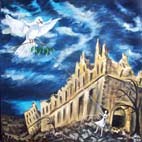In his opening address on the slopes of Monte Cassino Avvocato Molle reminded us of the plight of the civilian victims, one of whom was amongst us. He then proceded to talk about the the soldiers who were victims; not only those who were killed on the battlefields, but also those who had to make the choice to kill. To be put in the position where you have to take another life or die oneself is also to become a victim, no matter who, according to history, has won the battle. My translation may not be too accurate, but I was moved by his words as he painted a picture of the destroyed community and then acknowledged the young men who gave their lives, or their youth, to liberate Italy.
The civilian survivor who addressed us next was a teenager at the time of the Battle of Cassino. He will be attending the exhibition in May, and with the aid of a translator will talk with the artists. With his family he was living in a cave below the abbey for two months. They moved into the Abbey which was crammed full of people and he was there when it was bombed. He told how he went out to fill a bottle with water from the trough outside the walls, and found a leaflet advising of the bombing of the abbey. He described in detail the reaction of the people inside when the news was given. The women cried and many prayed, while the logistics of evacuating were discussed in some disbelief that this could possibly happen. That night, only the children slept. When they heard the approaching bombers he and his fifteen year old brother fled, and were on the first floor close to the door when the bombs struck. He still feels some shame at running, leaving his parents as he sought better shelter. The family survived, but many were killed. Talking with him later he said to me "I don't understand why I survived. Why did I survive?"
During his story he became emotional, and paused a few times. Later I overheard him say to another older man "After 65 years when I talk about it I still see it so clearly, I still feel it strongly. If 100 years pass I know it will be as strong".
Next on our agenda was a walk along a track behind the abbey, where we were "interrupted" by a re-enactor in full American uniform. Roberto Molle then described the participation of the US Forces, and gave a lesson on the uniform and the conditions the soldiers faced wearing little protection from the terrible wet and cold. Our next stop along the same track was to see more history, this time re-enactors in German uniforms, a paratrooper in full uniform and soldiers with communication equipment were set up below the track. It was a little disconcerting as two of the re-enactors looked very young, as the soldiers were, and made me think of the painting below. Often I am a little concerned when I see re-enactors apparently enjoying this activity as one would a sport; today it was good to see re-enactors educating us about the terrible conditions in which the battle was fought.
When you walk through the cemeteries it is the ages of the soldiers that affects me. And in every cemetery, no matter how many times I visit, I think "Each one of these soldiers had a mother".
I believe that a culture of peace begins in the home. I believe that it is the women who, with the help of men, will be the most prolific peace-makers. If every country sent out as many peace workers as it does soldiers into the world, how powerful a movement that would be. But when I see the interest men have in weapons and strategies (aside from history) I see again that it will be the women, the teachers and the peaceworkers educating the children who will make the difference.
We continued with various stops to learn more about what happened on Monte Cassino. At the summit of Point 593, the hill above the abbey, is the large white obelisk that is monument to 1000 Polish soldiers killed over a period of three days. On the monument, in four languages, is the following:
We Polish soldiers
For our freedom and yours
Gave our souls to God
Our lives to the soil of Italy
And our hearts to Poland.
Below: Watercolour by Sarah Scott entitled "Remember".













No comments:
Post a Comment